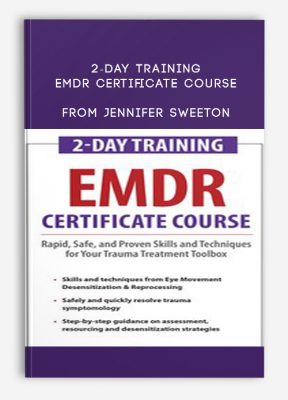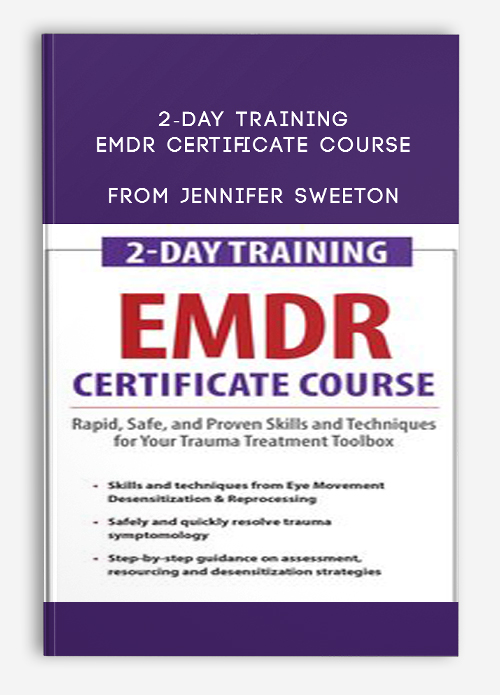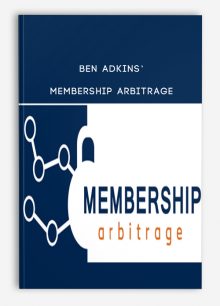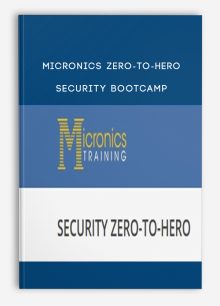2-Day Training: EMDR Certificate Course: Rapid, Safe and Proven Skills and Techniques for Your Trauma Treatment Toolbox from Jennifer Sweeton
$439.00 $127.00

2-Day Training: EMDR Certificate Course: Rapid, Safe and Proven Skills and Techniques for Your Trauma Treatment Toolbox from Jennifer Sweeton
Watch this 2-Day EMDR Certificate Course recording and discover how this powerful, evidence-based treatment has helped thousands of clients safely and rapidly process their traumas so they can reclaim their lives!
You’ll learn:
- How EMDR can be used to overcome avoidance in clients
- How EMDR techniques can help clients resolve traumatic memories
- When and with which clients EMDR should be used
- How to emphasize safety during sessions
- How the 8-phase model is used in treatment
Learn how EMDR can help clients who desperately need relief from trauma!
***This training is not affiliated with EMDRIA and does NOT qualify towards EMDRIA credits, training, or certification
- Establish the role of the autonomic nervous system in trauma symptomology.
- Articulate the clinical implications of the freeze response in trauma treatment.
- Characterize the potential neurobiological mechanisms of change in the empirically validated EMDR approach.
- Specify how EMDR techniques can build dual awareness in clients to treat the avoidance that makes trauma treatment challenging.
- Communicate the 8 Phases of the EMDR protocol.
- Determine which clients you should use EMDR with.
- Analyze resourcing strategies from EMDR that clinicians can use to help facilitate the processing of trauma.
- Characterize how EMDR techniques can be used to reinforce and activate positive neural networks.
- Communicate how EMDR can be modified to work with complex/developmental trauma to directly treat traumatic memories.
- Evaluate strategies that can help foster the critical connection between client and therapist in EDMR therapy.
- Articulate the research limitations and potential risks associated with EMDR.
- Establish the order of operations for attachment-based EMDR treatment to resolve relational trauma.
Get 2-Day Training: EMDR Certificate Course: Rapid, Safe and Proven Skills and Techniques for Your Trauma Treatment Toolbox from Jennifer Sweeton on Salaedu.com
Trauma and Neuroscience
- Key brain areas involved in trauma
- Polyvagal Theory, and types of freeze responses
- Trauma and insecure attachment
- The neuroscience of developmental trauma
- Clinical implications of the freeze response
How the EMDR Approach Works
- The neuroscience of exposure therapy and cognitive therapy
- The neuroscience of relaxation exercises
- EMDR and other “transformative therapies”
- Why EMDR works so well from a brain perspective
Trauma Symptoms and Assessment Tools
- Traumatic memories and intrusive thoughts
- Phobias and anxiety: Insula hyperactivation
- Emotional hijackings and implicit memory
- Avoidance cluster of symptoms
- Why treating avoidance in trauma is critical
- DSM-5® symptoms in a nutshell
- Connecting to a diagnosis
- Simple vs. complex trauma
- Intergenerational trauma
- Symptom clusters and physical manifestations
- CAPS-5 and PCL-5
- Primary Care PTSD Screen
- Dual diagnosis
Overcome Avoidance with EMDR
- Dual awareness
- What you are thinking about is the network you’re in
- Activate networks for change
- Neurons that fire together, wire together (Hebbb’s Rule)
- EMDR as neuroentrainment
When to Use EMDR in Treatment
- Demonstrations and experiential exercises
- Single event trauma
- Anxiety disorders involving imaginal exposure
EMDR Trauma Treatment: The Original 8-Phase Model
- Client history and treatment planning
- How to resource: Create as safe space
- Assessment: Choose a target, SUDS, connect with the image/emotions/thought
- Desensitization: Tactile vs. auditory vs. eye movement
- How to use touchpoints, Theratapper, CDs
- Positive Cognition Installation: Likert scale 1-7
- Body Scan: Locate tension and distress in the body
- Closure: Close the neural network and the 6-hour window
- Re-evaluation
Demonstration of Original 8-Phase Model
- Presenter demonstration
- Attendee dyad practice of the 8-phase model
EMDR Techniques to Resolve Traumatic Memories
- Modifications for Complex/Developmental Trauma
- Do not use standard protocol – Rationale for modifications
- Resourcing strategies
- Techniques to reinforce and activate positive neural networks
- Relevance of Polyvagal Theory, early trauma, and EMDR
- Sensory motor modifications and somatic approaches
- How to build Dual Awareness
- EMDR techniques to bring traumatic memories from the limbic system into the prefrontal cortex
Attachment-Based EMDR: Strategies to Treat Relational Trauma
- Strategies to foster the critical connection between client and therapist
- Mirror neuron activation
- How to emphasize safety during sessions
- Guidance on order of operations
Research Limitations and Potential Risks
Get 2-Day Training: EMDR Certificate Course: Rapid, Safe and Proven Skills and Techniques for Your Trauma Treatment Toolbox from Jennifer Sweeton on Salaedu.com
1 review for 2-Day Training: EMDR Certificate Course: Rapid, Safe and Proven Skills and Techniques for Your Trauma Treatment Toolbox from Jennifer Sweeton
Add a review Cancel reply
Related products
Internet Marketing Courses
Shop of Moxie – The 2015 Six Appeal Process from Ash Ambirge
Internet Marketing Courses
Internet Marketing Courses
Internet Marketing Courses
Internet Marketing Courses
Internet Marketing Courses










king –
We encourage you to check Content Proof carefully before paying.
“Excepted” these contents: “Online coaching, Software, Facebook group, Skype and Email support from Author.”
If you have enough money and feel good. We encourage you to buy this product from the original Author to get full other “Excepted” contents from them.
Thank you!